-
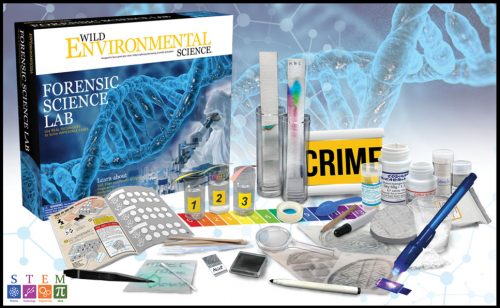 BECOME A DETECTIVE -- Use real techniques to match fingerprints, analyze DNA, identify fibers, test for poisons, cast footprints and discover secret messages. Set the scene with the crime scene tape! INCLUDES 66 PIECES -- This CSI kit features tools and ingredients for each experiment. Some household items are required: paper, plate, scissors, old shoes and sweaters, a mirror/shiny surface and a glass. Please note: We are an Amazon Associate and we earn from qualifying purchases found on this page. There is no cost to you and we thank you for your support!
BECOME A DETECTIVE -- Use real techniques to match fingerprints, analyze DNA, identify fibers, test for poisons, cast footprints and discover secret messages. Set the scene with the crime scene tape! INCLUDES 66 PIECES -- This CSI kit features tools and ingredients for each experiment. Some household items are required: paper, plate, scissors, old shoes and sweaters, a mirror/shiny surface and a glass. Please note: We are an Amazon Associate and we earn from qualifying purchases found on this page. There is no cost to you and we thank you for your support! -
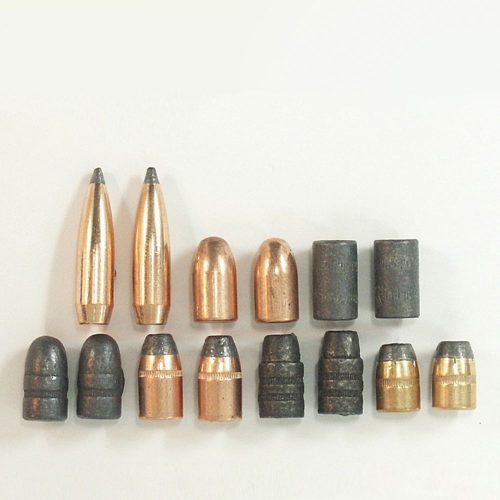 These 14 unfired bullets include 2 each of jacketed, semi-jacketed hollow point, semi-jacketed soft point, lead round nose, semi-wadcutter, wadcutter, and boat tail bullets. Makes a great addition to the Basic Firearm Identification Kit (item #212151) and can be used as part of a practical exam sample. Note: Not for use by children 12 and under.
These 14 unfired bullets include 2 each of jacketed, semi-jacketed hollow point, semi-jacketed soft point, lead round nose, semi-wadcutter, wadcutter, and boat tail bullets. Makes a great addition to the Basic Firearm Identification Kit (item #212151) and can be used as part of a practical exam sample. Note: Not for use by children 12 and under. -
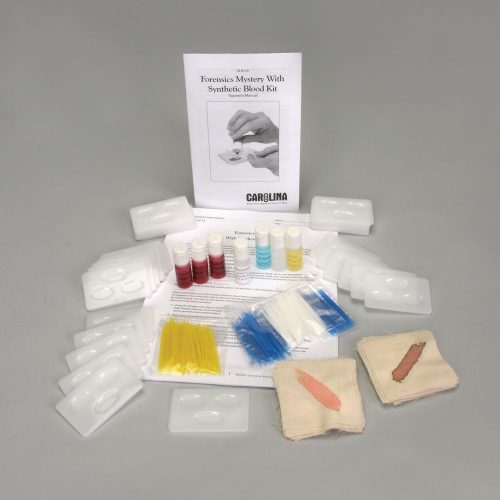 Students perform a simulated test for the presence of blood on evidence collected from 2 suspects in a murder case. They then use synthetic blood typing to test whether either suspect can be linked to the crime. Kit contains enough materials for a class of 30. Note: Use with Carolina™ Synthetic Blood products and accessories only. Not designed for actual blood typing
Students perform a simulated test for the presence of blood on evidence collected from 2 suspects in a murder case. They then use synthetic blood typing to test whether either suspect can be linked to the crime. Kit contains enough materials for a class of 30. Note: Use with Carolina™ Synthetic Blood products and accessories only. Not designed for actual blood typing -

 Biorama™ preparation. Certain insects offer a lot of clues for forensic scientists trying to determine the time of death. This hands-on exhibit features several of these insects and presents students with a visual understanding of just how insect life cycles serve as biological timers. The display shows the life stages of the blowfly using examples of eggs, larva, pupa, and adult with a description of the timing for each stage. The rove or hister beetle is similarly featured with examples of the egg, larva, and adult stages. Other general indicators included are the dermestid beetle and clothes moth larva. All specimens, stored in vials, are fully labeled and housed in a 6 x 8" display case that brings crime scene science to the classroom.
Biorama™ preparation. Certain insects offer a lot of clues for forensic scientists trying to determine the time of death. This hands-on exhibit features several of these insects and presents students with a visual understanding of just how insect life cycles serve as biological timers. The display shows the life stages of the blowfly using examples of eggs, larva, pupa, and adult with a description of the timing for each stage. The rove or hister beetle is similarly featured with examples of the egg, larva, and adult stages. Other general indicators included are the dermestid beetle and clothes moth larva. All specimens, stored in vials, are fully labeled and housed in a 6 x 8" display case that brings crime scene science to the classroom. -
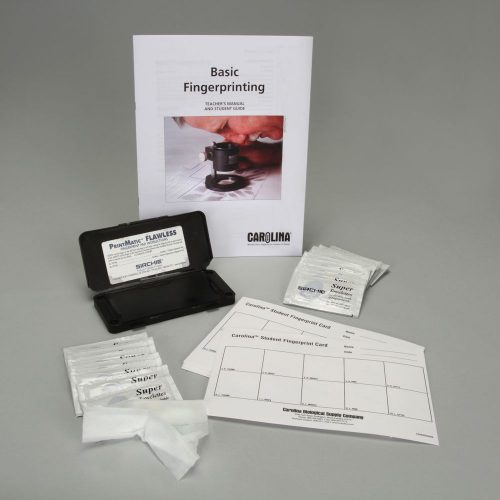 Put your print on your next classroom activity. This kit covers all the basics of fingerprinting and offers a truly unique lesson for students in any grade. It features a high quality, professional-grade ink pad, allowing your students to make great prints. Also includes extremely effective ink removal towelettes, eliminating additional mess or hassle.
Put your print on your next classroom activity. This kit covers all the basics of fingerprinting and offers a truly unique lesson for students in any grade. It features a high quality, professional-grade ink pad, allowing your students to make great prints. Also includes extremely effective ink removal towelettes, eliminating additional mess or hassle.- Perfect introductory fingerprinting activity
- Introduce concepts such as pattern recognition, structure and function, and data analysis
- Engage your students with realistic forensics materials
-
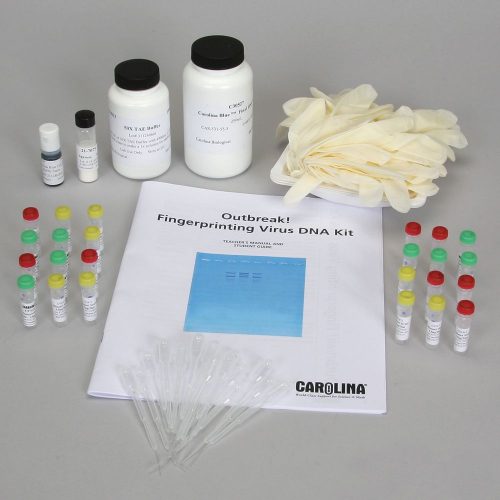 Intermediate - Easy to perform; requires some background knowledge. With this easy-to-use kit students become virus hunters as they interpret DNA fingerprints to identify the viral strain responsible for a potentially deadly fictitious disease outbreak. Students load harmless pre-digested DNA samples onto agarose gels and separate the fragments to produce fingerprints. References to articles on emerging diseases are included so your class can learn more about them. Materials supplied are sufficient for 8 student groups.
Intermediate - Easy to perform; requires some background knowledge. With this easy-to-use kit students become virus hunters as they interpret DNA fingerprints to identify the viral strain responsible for a potentially deadly fictitious disease outbreak. Students load harmless pre-digested DNA samples onto agarose gels and separate the fragments to produce fingerprints. References to articles on emerging diseases are included so your class can learn more about them. Materials supplied are sufficient for 8 student groups. -
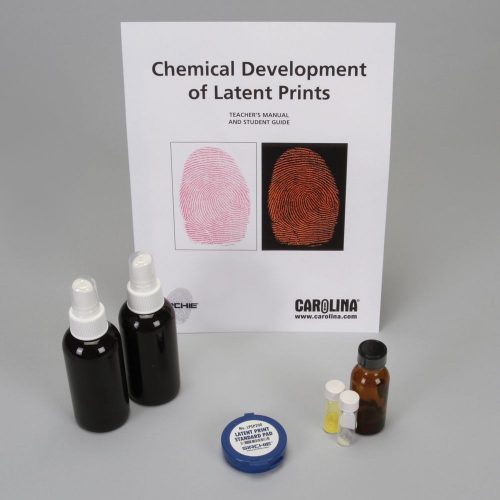 Develop excitement during your next forensics lesson! Grade 9–College. Give your students the opportunity to become crime scene technicians as they discover the science of latent fingerprint development. Kit is fully correlated to the Next Generation Science Standards* (NGSS) and includes free 1-year access to a digital teacher's manual and student guide download. Activity is designed for a class of 32 students working in 8 groups of 4. Students will:
Develop excitement during your next forensics lesson! Grade 9–College. Give your students the opportunity to become crime scene technicians as they discover the science of latent fingerprint development. Kit is fully correlated to the Next Generation Science Standards* (NGSS) and includes free 1-year access to a digital teacher's manual and student guide download. Activity is designed for a class of 32 students working in 8 groups of 4. Students will:- Develop fingerprints using ninhydrin and DFO
- Observe fingerprints developed by DFO with an alternative light source
- Compare running and non-running solvents for development of prints on a document
- Document the evidence collection process
-
 This kit takes your forensics class to the next level by giving students the opportunity to analyze DNA samples from a (fictitious) crime scene. Students immerse themselves in attempting to identify the culprit, learning more about DNA profiling and the role of tandem repeats in the analysis. They build on that knowledge with a hands-on investigation of the samples using PCR amplification and gel electrophoresis to help close the case.
This kit takes your forensics class to the next level by giving students the opportunity to analyze DNA samples from a (fictitious) crime scene. Students immerse themselves in attempting to identify the culprit, learning more about DNA profiling and the role of tandem repeats in the analysis. They build on that knowledge with a hands-on investigation of the samples using PCR amplification and gel electrophoresis to help close the case. -
 Forensic firearm identification is easy with this kit's real-world samples, actual crime lab procedures, and a PowerPoint® lecture with over 100 high-quality photographs and 8 video clips. After completing the 3 lab exercises, students can analyze firearm, ammunition, and toolmark evidence to determine if a particular gun was used to commit a crime. All fired bullets, cartridge cases, and barrels are safe. Kit includes enough materials for 30 students working in pairs. Enhance your lecture with the Cartridge Case Comparison Poster (item #212156) and the Bullet Comparison Poster (item #212157). Note: Not for use by children 12 and under.
Forensic firearm identification is easy with this kit's real-world samples, actual crime lab procedures, and a PowerPoint® lecture with over 100 high-quality photographs and 8 video clips. After completing the 3 lab exercises, students can analyze firearm, ammunition, and toolmark evidence to determine if a particular gun was used to commit a crime. All fired bullets, cartridge cases, and barrels are safe. Kit includes enough materials for 30 students working in pairs. Enhance your lecture with the Cartridge Case Comparison Poster (item #212156) and the Bullet Comparison Poster (item #212157). Note: Not for use by children 12 and under. -
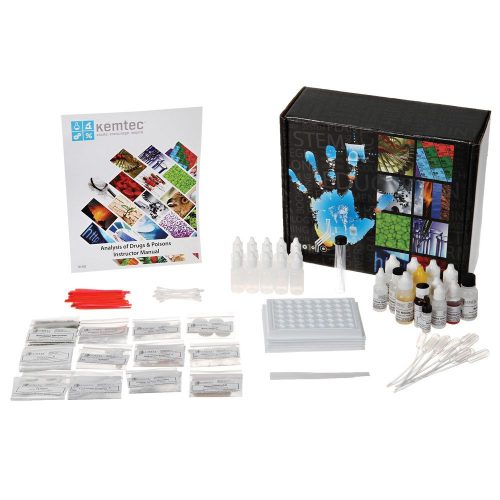 Kemtec®. Chemical analytical techniques are used to identify over-the-counter drugs and to detect heavy metals in a simulated poisoning. Simulated controlled substances are tested. Students are introduced to qualitative analysis in the interesting context of criminal investigation. Materials are sufficient for 24 students working in 6 groups of 4 students.
Kemtec®. Chemical analytical techniques are used to identify over-the-counter drugs and to detect heavy metals in a simulated poisoning. Simulated controlled substances are tested. Students are introduced to qualitative analysis in the interesting context of criminal investigation. Materials are sufficient for 24 students working in 6 groups of 4 students. -
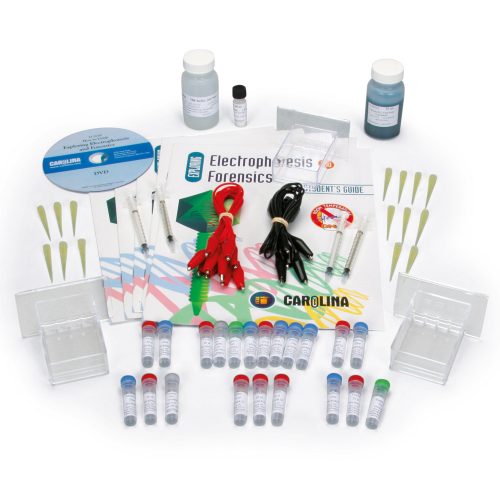 Easy to perform; requires some background knowledge.
Easy to perform; requires some background knowledge.- Introduces advanced concepts of PCR and DNA fingerprinting
- Gels can be run in 45 minutes with five 9-V batteries or overnight with 1 battery
- Introduces forensic techniques

